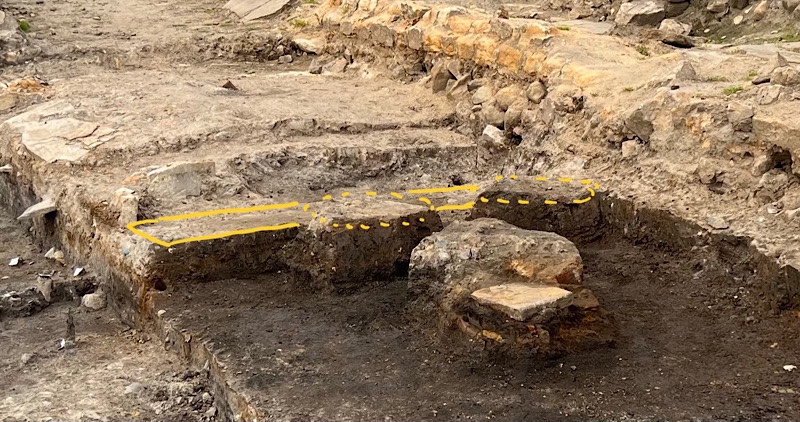Well, where to start! Today was an exhilarating ride and one that really seemed to come out of nowhere, with a plethora of interesting and unusual finds, entirely from the same period IV context that had yielded virtually nothing yesterday.

We began the morning tasked with completing the first pass across our assigned section – exposing the floor of a period IV level – having run out of time to do it yesterday. The couple of islands we’d left unfinished seemed like a quick job, allowing us to then be able to get stuck into the anaerobic, period III level beneath it. Having sorted through dozens of virtually entirely barren buckets from this level yesterday, what came next took us all completely by surprise.

I volunteered to chunk these remaining pieces, thinking I could quickly get them out for us in large blocks; however, the second or third chunk I attempted to cut was hindered by a pair of substantial stones. Mike – who was helping to get the chunks into buckets for sorting – realized before I did that there was a gentle curvature on one; further troweling revealed they formed a complete circle with a central hole – the classic size and shape of a Roman quern. These were used to grind wheat into flour and several are found in a typical year at Vindolanda. This one had cracked in two in antiquity, presumably causing it to be discarded in the early years of the second century.

Not five minutes later, Pippa came over, clutching a lead weight she’d found in the first few buckets; these were important tools, as a standard in measuring quantity, using a balance scale. Another ten minutes passed and then Mike spotted an object, it’s tip poking out of the just-exposed trench side. Andy was called for guidance and his reaction was of immediate excitement, confident it was something quite unusual. We took several minutes to cut it out within a larger block, to make sure it made it down to the lab undamaged. I can’t describe it further here, other than give you a tantalizing glimpse of it in the slab of sticky, clay rich soil, below. Hopefully we’ll hear more about it in the next few weeks.


Before lunch we had three more very nice finds: a bone handle, likely from a small knife; a large piece of leather that we couldn’t examine completely (perhaps a tent panel, but could just be an offcut) because it is impaled by a post from a later wattle and daub partition/fence; a truly beautiful, black glass gaming counter.



After lunch it was time to do a cleaning scrape and brush up across the whole of our section of the trench, before one of the three bursary students, Grace, generated a 3D model using the Scaniverse app. With that in hand we began the next phase, going down about 10-15cm into the period III level, allowing Pippa and Mike to begin exposing a well-preserved wattle and daub fence.

I almost forgot to mention two other aspects of this memorable day.
First, Mike and I made a section passing through the middle of two of the holes created by the recent loss of wooden posts, due to the drying resulting from climate change; this sectioning now marks the northern end of the area we’ve been focused on this week. Documenting these holes will be important to bring attention to the dramatic impact of climate change on archaeology, showing that the old maxim that artifacts in the ground are safe is no longer true.
Second, today also brought a satisfying explanation for the long, wide field of stone we toiled over in week one: Andy had a eureka moment when he suddenly remembered working on the foundation of a large Antonine building in 2006 that looked exactly like this, about 20 meters south. We have now almost certainly found the northern wall of the same, substantial building.

This was an unforgettable day, producing the most diverse set of high quality finds I’ve ever seen on a single day in “my” trench. To underscore the point, I have not even included description of two additional finds that are in the forbidden category, and two others I haven’t covered because they’re less exciting. A very tough act to follow for the last day of period 7 tomorrow.
